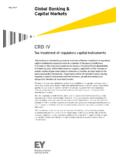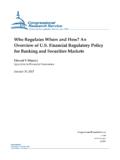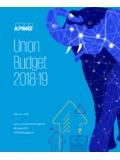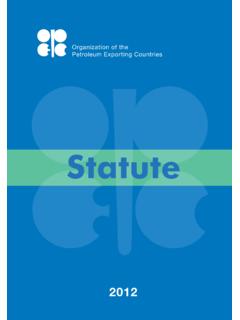Transcription of KKR Capital Markets Limited Pillar 3 Disclosures June 2017
1 KKR Capital Markets Limited Pillar 3 Disclosures june 2017 1. Background The European union Capital Requirements Directive sets out the regulatory framework governing the amount of Capital which must be maintained by credit institutions and investment firms. In the UK the directive has been adopted by the Financial Conduct Authority ( FCA ) within the Prudential Sourcebook ( IFPRU ) for management investment firms. The regulatory framework comprises three pillars : Pillar 1 set out the minimum Capital requirements that a firm is required to meet; Pillar 2 requires the firm to assess the amount of Capital that would be adequate to cover the risks that the firm has or may be exposed to (Internal Capital Adequacy Assessment Process); and Pillar 3 requires the firm to disclose its risk management strategies, policies and processes, Capital resources, Capital requirements and the firm s approach to assessing Capital adequacy.
2 The purpose of this document is to provide the Pillar 3 Disclosures required in BIPRU Chapter 11. The requirements provide for the omission of one or more of the required Disclosures if such information is considered to be immaterial, proprietary or confidential. KKR Capital Markets Limited ( KCML or the Firm ) is a private Limited company authorised by the UK FCA as a managed IFPRU investment firm. KCML is an indirect subsidiary of Kohlberg Kravis Roberts & Co ( KKR ), a Delaware entity. KKR is a US Securities and Exchange Commission ( SEC ) registered investment advisor. KCML representatives currently carry out two main activities: i. KCML Capital Markets , which is responsible for carrying out Capital Markets activities in Europe; and ii. KCML CPG, which is responsible for marketing the funds (the KKR Funds ), managed and advised by KKR to European investors. 2.
3 Scope of Application KCML is regulated by the FCA on a stand-alone basis and is not subject to consolidated supervision. The Pillar 3 Disclosures contained within this document therefore apply to KCML on an individual basis. 3. Frequency of Disclosure The Firm publishes Pillar 3 Disclosures on at least an annual basis. Given the scale and range of its operations and complexity, the Firm assesses that there is no need to publish some or all of its Disclosures more frequently than annually. 4. Risk Management Our risk management policies and processes are comprehensive and proportionate to the nature and scale of KCML s activities. The KCML Board of Directors have ultimate responsibility for the wider risk management of the Firm and has appointed a member of the KCML Board of Directors as the Head of Risk Management with the responsibility for implementing and maintaining risk management within KCML.
4 The KKR Global Risk Committee is responsible for identifying, prioritizing and monitoring risk for KKR on a global basis and is accountable to KKR s Management Committee, which is responsible for KKR s global operations. One member of the KCML Board of Directors is also a member of the Global Risk Committee. Business risk The following risks are considered to be the most significant business risks: a. Risk of underwriting pressure on the balance sheet and changes in market conditions and the possibility of poor underwriting decisions. Underwriting risk is controlled and managed by ensuring that all new underwriting transactions are approved by the Underwriting and Balance Sheet Committee. KCML considers the risks in its business carefully and seeks to reduce and mitigate risks so as to ensure it maintains an appropriate Capital position. b. Risk regarding the ability to attract and retain appropriate investors into the KKR Funds and the management of investor relations.
5 To manage the risks regarding the ability to attract and retain appropriate investors into the KKR Funds and to successfully manage investor relations, a team of individuals with solid experience in Capital raising and investor relations perform marketing activities for the KKR Funds and manages investor relationships. Operational risk Operational risk includes a risk of loss resulting from inadequate or failed internal processes relating to human resources, legal, compliance, IT systems, financial reporting, public affairs, tax and insurance. KCML has processes and controls in place to manage and mitigate operational risks and, as a result, operational risks are not considered to be net material risks to the business. Credit and market risk KCML does not have material exposures to credit risk save for risk on banks with which it deposits funds and no material net exposures to market risk.
6 Foreign exchange risk The risk that changes in the value of non-sterling denominated income and expenses, and assets or liabilities, will adversely impact the Capital position of the Firm. The Firm may be exposed to risks associated with fluctuations in exchange rates due to the fact that its revenues and expenses may be denominated in different currencies. The Firms revenues and expenses are principally charged or incurred in GBP, Euros or Dollars. 5. Capital Resources and Capital Adequacy KCML obtained regulatory approval in 2008. As at 31 December 2016, KCML s Capital resources were comprised of Tier 1 Capital only, which included share Capital , a Capital contribution reserve and audited accumulated profits. The Firms Capital position as of 31 December 2016 is shown below. '000 Ordinary share 4,050 Capital contribution 19,309 Accumulated profits1 (2,424) Tier 1 Capital 20,935 1 During the financial year the company paid dividends to its parent company of 15m (2015: 15m).
7 In addition, KCML currently has access to additional Capital resources through KCML s direct parent company. KCML is a managed IFPRU investment firm and is bound by the Capital Requirements Directive ( CRD IV ). KCML is authorized and regulated by the Financial Conduct Authority (the FCA ). 6. Minimum Capital Requirement The Firms overall regulatory Capital requirements are determined after performing Pillar 1 Capital calculations, assessing Pillar 2 Capital requirements and taking into account any Individual Capital Guidance ( ICG ) issued by the FCA. The calculation of Pillar 1 and Pillar 2 Capital requirements allows the Firm to determine, and subsequently monitor, the appropriate amount of Capital to be held based on its risk profile. During the financial year ended 31st December 2016, the Firm maintained surplus Capital resources at all times to satisfy its minimum Capital requirements.
8 The Firms Pillar 1 Capital resources requirements at 31 December 2016 are detailed below. The Firms Pillar 1 Capital requirements are calculated in accordance with the guidance set under the Capital Requirements Directive. '000 Operational Risk 3,360 Credit Risk 847* market Risk - FX Risk 473 Pillar I Requirement 4,680 *Arising from cash at banks and fee receivables Pillar 2 requires firms to assess the amount of internal Capital they consider adequate to cover all of the risks to which they are, or are likely to be, exposed to. It also requires firms to consider the costs associated with winding down the Firm (orderly wind down) and various stressed scenarios. The Firms Pillar 2 requirement has been assessed as being 10,292k (inclusive of Pillar 1 items above and Capital buffers), and therefore is the minimum Capital requirement of the Firm. 7. Oversight The Directors monitor the on-going compliance of the firm with its Capital requirements and assess the impact on Capital adequacy of each deal prior to approval.
9 This ensures that the firm maintains adequate Capital to cover its credit, market and operational risks at all times. 8. Internal Capital Adequacy Assessment Process ( ICAAP ) KCML conducts at least annually an internal assessment of the amount of Capital that is considered adequate to cover the risks facing the firm s current and future activities. Determination of the business strategy for the Firm includes the projection of financial profitability, Capital resources and Capital requirements. The key risks to which the business is or might be exposed are considered along with the amount of Capital that would be considered adequate to cover the Firm in the event that those risks were to crystallize. In addition, the economic environment and the impact of adverse economic conditions on the Firm s profitability and Capital position are considered, as well as the actions that management would take in those situations.
10 9. Remuneration Code KCML is subject to the FCA s rules on remuneration. The rules are contained in the FCA s Remuneration Code located in the SYSC Sourcebook of the FCA s Handbook. The Remuneration Code ( the RemCode ) covers an individual s total remuneration both fixed and variable. KCML in line with KKR group remuneration policies offers a fixed base salary to its employees and also a variable remuneration, which is dependent on individual and business performance. Certain KCML representatives including the CPG group and certain support and control personnel are employed by affiliates of KCML. In such cases such affiliate is responsible for funding their remuneration. In certain cases KCML may reimburse certain affiliates for compensation costs. KCML s policy is designed to ensure compliance with the RemCode and the Firm s compensation arrangements: Do not encourage excessive risk taking; Are consistent with and promote effective risk management; Include measures to avoid conflict of interest; and Are in line with the Firm s business strategy, objectives and interests.



![g^ÔfYf[aYd afkljme]flkak egj][gehd]p& Lae]lgaehd]e]fl [`Yf ]&](/cache/preview/b/5/9/1/d/b/b/8/thumb-b591dbb864bb015fedab5e78503dfa32.jpg)





